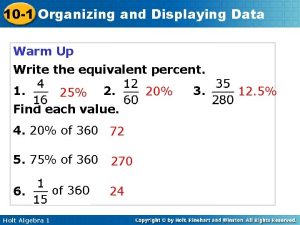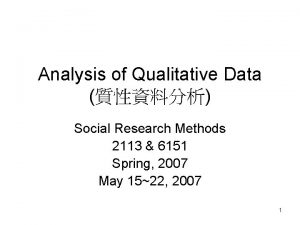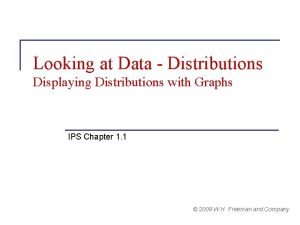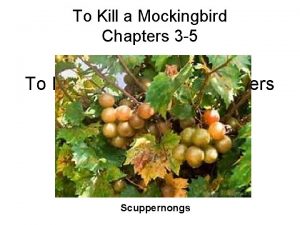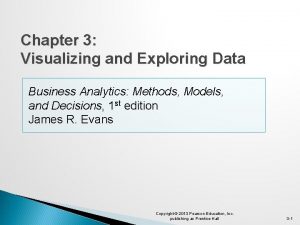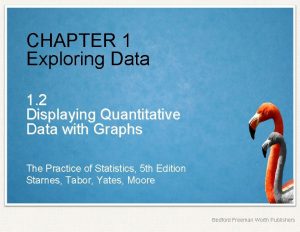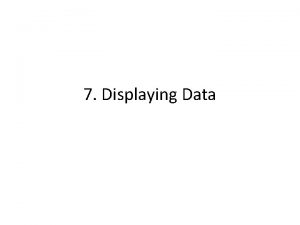CHAPTER 1 Exploring Data 1 2 Displaying Quantitative




















- Slides: 20

CHAPTER 1 Exploring Data 1. 2 Displaying Quantitative Data with Graphs The Practice of Statistics, 5 th Edition Starnes, Tabor, Yates, Moore Bedford Freeman Worth Publishers

Displaying QUANTITATIVE Data with Graphs Learning Objectives After this section, you should be able to: ü MAKE and INTERPRET dotplots and stemplots of quantitative data ü DESCRIBE the overall pattern of a distribution and IDENTIFY any outliers ü IDENTIFY the shape of a distribution ü MAKE and INTERPRET histograms of quantitative data ü COMPARE distributions of quantitative data The Practice of Statistics, 5 th Edition 2

Dotplots One of the simplest graphs to construct and interpret is a dotplot. Each data value is shown as a dot above its location on a number line. How to make a dotplot: 1)Draw a horizontal axis (a number line) and label it with the variable name. 2)Scale the axis from the minimum to the maximum value. 3)Mark a dot above the location on the horizontal axis corresponding to each data value. Number of Goals Scored Per Game by the 2012 US Women’s Soccer Team 2 1 5 2 0 3 1 4 1 2 4 13 3 4 14 4 3 3 4 2 2 4 The Practice of Statistics, 5 th Edition 1 3

Examining the Distribution of a QUANTITATIVE Variable The purpose of a graph is to help us understand the data. After you make a graph, always ask, “What do I see? ” How to Examine the Distribution of a Quantitative Variable 1)In any graph, look for the overall pattern and for striking departures from that pattern. 2)Describe the overall pattern of a distribution by its: • Shape • Center Don’t forget your SOCS! • Spread 3)Note individual values that fall outside the overall pattern. These departures are called outliers. The Practice of Statistics, 5 th Edition 4

Examining the Distribution of a Quantitative Variable • Instead of SOCS…. • CUSS & BS • C—Center (mean or median) • U—Unusual Features (outliers or gaps in data) • S—Shape (skewed, peaks, clusters) • S—Spread (range, standard deviation, IQR) • & • B—BE • S—SPECIFIC The Practice of Statistics, 5 th Edition 5

Examining the Distribution of a Quantitative Variable Number of Goals Scored Per Game by the 2012 US Women’s Soccer Team Let’s use our informal understanding of these ideas to examine the graph of the U. S. women’s soccer team data. C—Center: The “midpoint” of the 25 values shown in the graph is the 13 th value we count in from either end. We can confirm that the midpoint is at 3. This tells us that in a typical game during the 2012 season, the U. S. women’s soccer team scored about 3 goals. U—Unusual features: There is a large gap between 5 and 13. Two outliers exist to the far right at 13 and 14. The Practice of Statistics, 5 th Edition 6

Examining the Distribution of a Quantitative Variable Number of Goals Scored Per Game by the 2012 US Women’s Soccer Team S—Shape: The dotplot has a peak at 4 and a single main cluster of dots between 0 and 5. This tells us that the U. S. women’s soccer team scored between 0 and 5 goals in most of its games with 4 being the most common value, the mode. S—Spread: The data vary from 0 goals scored to 14 goals scored. Be Specific! The Practice of Statistics, 5 th Edition 7

Describing Shape When you describe a distribution’s shape, concentrate on the main features. Look for rough symmetry or clear skewness. A distribution is roughly symmetric if the right and left sides of the graph are approximately mirror images of each other. A distribution is skewed to the right (right-skewed) if the right side of the graph (containing the half of the observations with larger values) is much longer than the left side. It is skewed to the left (left-skewed) if the left side of the graph is much longer than the right side. Symmetric The Practice of Statistics, 5 th Edition Skewed-left Skewed-right 8

Describing Shape UNIMODAL ONE PEAK The Practice of Statistics, 5 th Edition BIMODAL TWO PEAKS 9

Comparing Distributions Some of the most interesting statistics questions involve comparing two or more groups. Remember CUSS & BS whenever you compare distributions of a quantitative variable. Compare the distributions of household size for these two countries. C—Center: Household sizes for the South African students tended to be larger than for the U. K. students. The midpoints of the household sizes for the two groups are 6 people and 4 people respectively. The Practice of Statistics, 5 th Edition 10

Comparing Distributions Comparing the distributions of household size for these two countries. U—Unusual features: There don’t appear to be any outliers in the U. K. distribution. The South African distribution seems to have two outliers in the right tail of the distribution—students who reported living in households with 15 and 26 people. S—Shape: The distribution of household size for the U. K. sample is roughly symmetric and unimodal, while the distribution for the South Africa sample is skewed to the right and unimodal. The Practice of Statistics, 5 th Edition 11

Comparing Distributions Comparing the distributions of household size for these two countries. S—Spread: The household sizes for the South African students vary more (from 3 to 26 people) than for the U. K. students (from 2 to 6 people). AP Exam Tips: 1. Remember to discuss all four characteristics of the distribution. 2. Students must use phrases like “about the same as” or “is much greater then” when comparing Center and Spread to receive full credit. The Practice of Statistics, 5 th Edition 12

Stemplots Another simple graphical display for small data sets is a stemplot. (Also called a stem-and-leaf plot. ) Stemplots give us a quick picture of the distribution while including the actual numerical values. How to make a stemplot: 1)Separate each observation into a stem (all but the final digit) and a leaf (the final digit). 2)Write all possible stems from the smallest to the largest in a vertical column and draw a vertical line to the right of the column. 3)Write each leaf in the row to the right of its stem. 4)Arrange the leaves in increasing order out from the stem. 5)Provide a key that explains in context what the stems and leaves represent. The Practice of Statistics, 5 th Edition 13

Stemplots These data represent the responses of 20 female AP Statistics students to the question, “How many pairs of shoes do you have? ” Construct a stemplot. 50 26 26 31 57 19 24 22 23 38 13 50 13 34 23 30 49 13 15 51 1 1 93335 1 33359 2 2 664233 2 233466 3 3 1840 3 0148 4 4 9 5 5 0701 5 0017 Stems The Practice of Statistics, 5 th Edition Add leaves Order leaves Key: 4|9 represents a female student who reported having 49 pairs of shoes. Add a key 14

Stemplots When data values are “bunched up”, we can get a better picture of the distribution by splitting stems. Two distributions of the same quantitative variable can be compared using a back-to-back stemplot with common stems. Females Males 50 26 26 31 57 19 24 22 23 38 14 7 6 5 12 38 8 7 10 10 13 50 13 34 23 30 49 13 15 51 10 11 4 5 22 7 5 10 35 7 0 0 1 1 2 2 3 3 4 4 5 5 Females “split stems” The Practice of Statistics, 5 th Edition 333 95 4332 66 410 8 9 100 7 Males 0 0 1 1 2 2 3 3 4 4 5 5 4 555677778 0000124 2 58 Key: 4|9 represents a student who reported having 49 pairs of shoes. 15

Histograms Quantitative variables often take many values. A graph of the distribution may be clearer if nearby values are grouped together. The most common graph of the distribution of one quantitative variable is a histogram. How to make a histogram: 1)Divide the range of data into classes of equal width. 2)Find the count (frequency) or percent (relative frequency) of individuals in each class. 3)Label and scale your axes and draw the histogram. The height of the bar equals its frequency. Adjacent bars should touch, unless a class contains no individuals. The Practice of Statistics, 5 th Edition 16

Histograms This table presents data on the percent of residents from each state who were born outside of the U. S. Class Count 0 to <5 20 5 to <10 13 10 to <15 9 15 to <20 5 20 to <25 2 25 to <30 1 Total 50 The Practice of Statistics, 5 th Edition Number of States Frequency Table Percent of foreign-born residents 17

Using Histograms Wisely Here are several cautions based on common mistakes students make when using histograms. Cautions! 1)Don’t confuse histograms and bar graphs. 2)Don’t use counts (in a frequency table) or percents (in a relative frequency table) as data. 3)Use percents instead of counts on the vertical axis when comparing distributions with different numbers of observations. 4)Just because a graph looks nice, it’s not necessarily a meaningful display of data. The Practice of Statistics, 5 th Edition 18

Data Analysis: Making Sense of Data Section Summary In this section, we learned how to… ü MAKE and INTERPRET dotplots and stemplots of quantitative data ü DESCRIBE the overall pattern of a distribution ü IDENTIFY the shape of a distribution ü MAKE and INTERPRET histograms of quantitative data ü COMPARE distributions of quantitative data The Practice of Statistics, 5 th Edition 19

Homework Page 41 # 37 -53, 65, 68 The Practice of Statistics, 5 th Edition Starnes, Tabor, Yates, Moore Bedford Freeman Worth Publishers
 Chapter 3 exploring quantitative data answers
Chapter 3 exploring quantitative data answers Data preparing exploring examining and displaying
Data preparing exploring examining and displaying Displaying quantitative data with graphs
Displaying quantitative data with graphs Displaying quantitative data with graphs
Displaying quantitative data with graphs Categorical data displays
Categorical data displays Collecting and displaying data
Collecting and displaying data Organizing and displaying data
Organizing and displaying data Displaying data from multiple tables
Displaying data from multiple tables Organizing and displaying data
Organizing and displaying data Data analysis qualitative and quantitative
Data analysis qualitative and quantitative Qualitative data analysis coding
Qualitative data analysis coding Petit fours sec
Petit fours sec Displaying distributions with graphs
Displaying distributions with graphs Diminutive to kill a mockingbird
Diminutive to kill a mockingbird Pygame default font
Pygame default font Visualizing and exploring data in business analytics
Visualizing and exploring data in business analytics Chapter 26 exploring the universe answers
Chapter 26 exploring the universe answers Exploring religions chapter 4 large
Exploring religions chapter 4 large Introduction to lifespan development
Introduction to lifespan development Exploring globalization textbook pdf chapter 11
Exploring globalization textbook pdf chapter 11 Religion
Religion






